Piriformis syndrome is defined as pain in the buttocks due to non-discogenic (arising from the disc) entrapment of the sciatic nerve in the sub gluteal space. This is one of five deeper-dive articles we will write as a follow-up to our causes of sciatica article from last month.
Approximately 10% of the 3 million cases of sciatica reported in this country each year are related to the piriformis or tissue in the sub gluteal space. In fact, the term Deep Gluteal Syndrome is now being preferred in some medical circles due to the many tissues that may cause pressure on the sciatic nerve in the sub gluteal space (buttocks). The sciatic nerve may be entrapped by fibrous bands containing blood vessels, the gluteal muscles, one of six deep rotators of the hip, the hamstrings or anatomical abnormalities. If you’re unsure of whether or not this deep gluteal syndrome is the cause of your pain, we recommend getting a physical examination. We will address the more commonly referred to muscle, the Piriformis.
The piriformis is a deep rotator muscle located in the buttocks. It is a small muscle that helps rotate the hip out. It can become involved in sciatica by either direct trauma causing it to spasm or if it responds to some mechanical irritation of adjacent tissue. The Piriformis can become tight, painful and give one symptoms of sciatica. The sciatic nerve usually passes adjacent to the muscle. In about 3% of individuals the nerve passes through the fibers of the muscle, which may result in a neuromuscular disorder in which the sciatic nerve is irritated by the piriformis muscle in the buttocks. The sciatic nerve is the longest nerve in the body which begins in the lower back and runs through hips, buttocks, legs, and feet on both sides.
Piriformis Syndrome Symptoms
Pain in the buttocks and/or radiating into the back of the leg and often down to the foot. Other common symptoms of piriformis syndrome include the sensation of pins and needles with tingling in the hip buttocks or thigh, a dull ache in the buttocks and/or restricted range of motion of the hip. Limping, increased pain at night, and less pain during the day are common. These symptoms are primarily on one side.
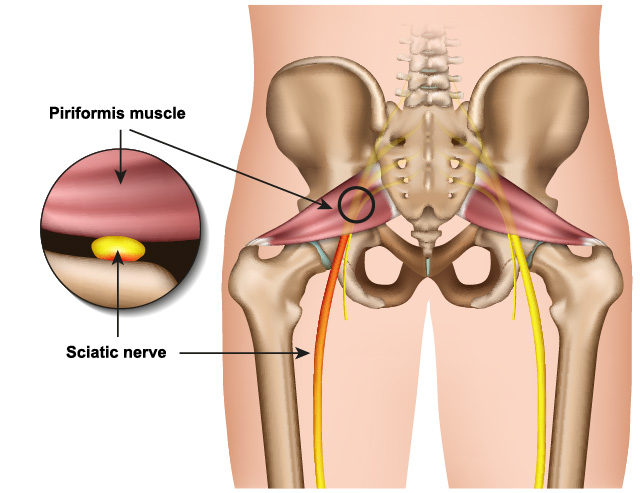
How to you know if it is the piriformis?
To determine if the piriformis is causing your pain, you must first rule out other causes of scaitica pain. It is not uncommon for issues in the back such as a disc problems and sacroiliac joint dysfunction to send pain to the buttocks. The quality of the pain and how it responds to certain stresses can help isolate the cause. Here are some clear signs the sciatica you are experiencing is originating from your piriformis:
The active piriformis syndrome test
- Lie on your side with your painful side up.
- Place the upside foot on the surface on which you are lying.
- Involved Knee is bent up and hip his rolled out.
- Have someone gentle try to push your top knee toward the surface on which you are lying while you actively drive your heel down and resist the push.
- If the symptoms are reproduced then this suggest the piriformis is involved.
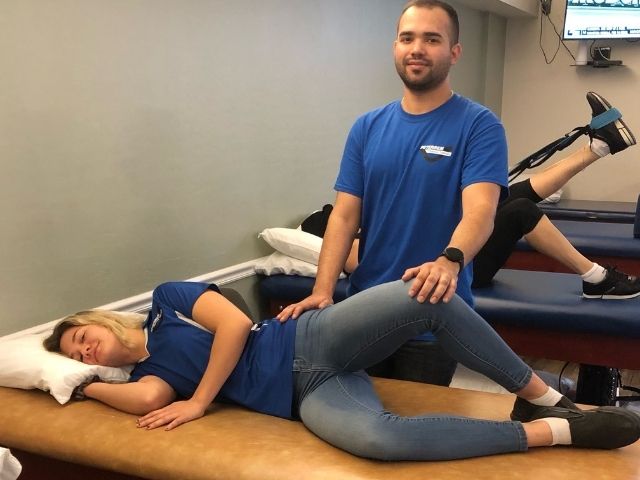
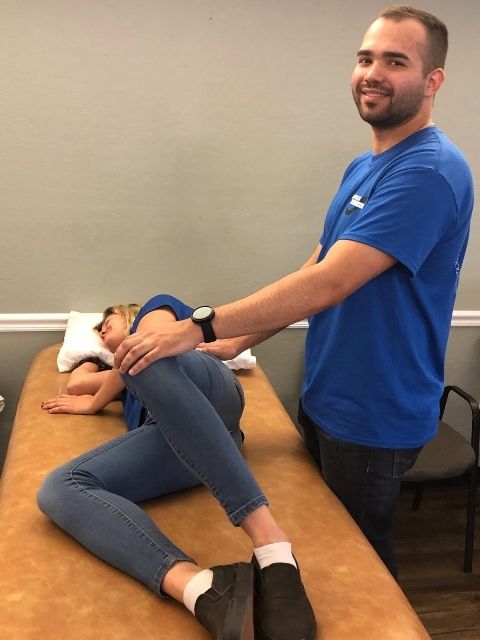
This test has been shown to have 78% sensitivity and 80% specificity. This means as a clinical test it is moderately reliable in isolating the piriformis as the cause of your sciatica.
Limited mobility test
- Sit in a chair with your knees together, feet flat on the floor.
- Roll your feet out way from each other.
- Compare mobility and check for pain. The involved side may have limited mobility and your pain may be reproduced.
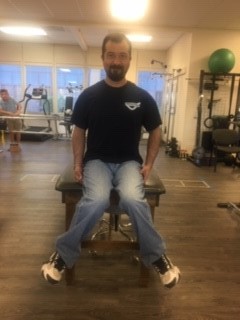
How to treat piriformis syndrome at home
Rest the area
The first thing we would suggest would be to rest. Avoid prolonged sitting if possible. If and when you must sit, change / alternate the surface upon which you sit. The next thing would be to treat the area with ice / heat. In an acute or recent injury, use ice. If this condition has persisted over one week, moist heat and ice applications can be alternated. Use which ever gives the greatest amount of relief.
Piriformis Syndrome Stretches
There are three main piriformis syndrome stretches I would recommend to begin managing your piriformis syndrome at home:
1. Piriformis Stretch
There are a number of ways to stretch the piriformis. One of the most common ways is to lay down on your back, and bring one leg up (bent knee). Use your hands to guide your knee up and across your body laterally until you feel the stretch.
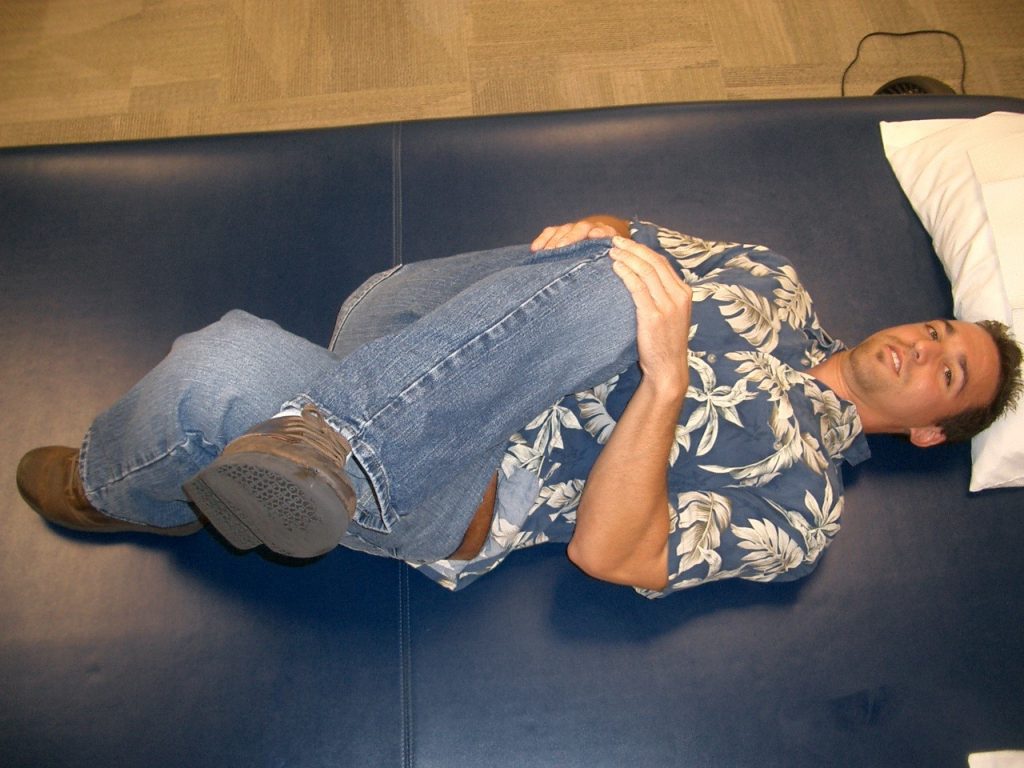
An alternative would be to use a lacrosse ball to release the area. There are plenty of methods of doing this – a simple search for “lacrosse ball piriformis” should reveal plenty of options.
2. Hamstrings
Stretching the hamstrings is also a good idea. You can pick your hamstring stretch of choice (there are many), but one of our favorites is:
Lie flat on the floor on your back and with knees bent until they form a 90 degree angle. Straighten one leg and use your hands (or a band wrapped around your foot) to pull the leg upwards until you feel a stretch.

3. Hip Flexors
As with the other muscles, there are numerous ways to stretch the hip flexors. One would be to lay on a bed or surface with your legs straight. Then let one leg hang down towards the flow as in the picture below. With your hands, grab your opposite leg and pull up towards your chest. Let gravity do the rest.
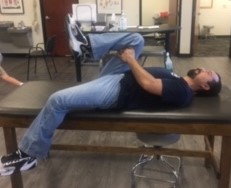
Other piriformis syndrome exercises:
There are numerous other activities that may decrease your symptoms and aid in your recovery. Cardio / conditioning, yoga, and lower extremity strengthening can do wonders for piriformis syndrome. Your mileage may vary – make sure to back off if you’re getting an unpleasant pain response from your exercise.
How your physical therapist can help with piriformis syndrome treatment
If you’re wondering how to heal piriformis syndrome more quickly, a physical therapist can be extremely helpful in the process. Physical therapy can help isolate the true origin of your pain, as well as use modalities such as electrical stimulation, ultrasound, cupping and dry needling to decrease pain. We are also trained in manual therapy to inhibit pain and muscle guarding (spasm) of the piriformis and surrounding tissue. We will also help you learn targeted therapeutic piriformis syndrome exercises to strengthen and improve the function of the piriformis and surrounding tissue. A physical therapist will also provide you with education to teach you how to minimize the stress to the sub gluteal area, improve your strength and endurance, prevent piriformis syndrome flareups and manage pain.
Remember you do not need to live in pain. If you need help or have questions, please contact your physical therapist or physician for medical advice or further assistance.
Next month, we will cover one of the other five most common causes of sciatica.

















